Hurricane Katrina will likely be recorded as the worst natural disaster in the history of
the United States, producing catastrophic damage and at least 1,836 casualties in
the New Orleans area, along the Mississippi Gulf Coast and in south Florida.
It formed over the Bahamas on August 23, 2005, and crossed southern Florida as a moderate Category 1 hurricane, but causing some deaths and flooding there, before strengthening rapidly in the Gulf of Mexico and becoming one of the strongest hurricanes on record. The storm weakened considerably before making its second and third landfalls as a Category 3 storm on the morning of August 29 in southeast Louisiana and at the Louisiana/Mississippi state line, respectively.
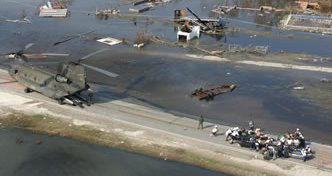 FEMA search and rescue team prepare to board a National Guard Chinook
FEMA search and rescue team prepare to board a National Guard Chinook
Coast Guard helicopters where already on scene and several days into the disaster, National Guard helicopter crews joined the desperate effort, using less well-equipped UH-1 Hueys hugging one or two survivors up time after time. And by the end of the week, the skies over New Orleans were a beehive of rotary wing activity, with craft as large as the huge Skycrane or tandem rotor Chinooks , large Sikorsky H-53s along with most every other helicopter model in the Armed Forces inventory.
The Army's III Corps and two Air Force rescue wings contributed over 30 helos as well. At the height of operations, the various elements of the Department of Defense had more than 350 helicopters and over 70 fixed wing aircraft involved in Katrina relief efforts. Below is a summary of the helicopter units deployed:
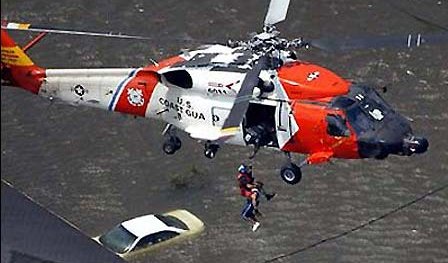
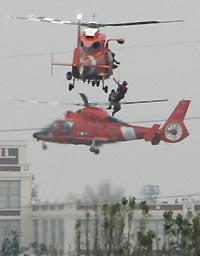
On the afternoon of the storm, NAS JRB New Orleans' emergency management team quickly moved into action to clear the runways and repair the control tower. Within four hours, flight operations began when the first Coast Guard HH-65 landed at the JRB to start relief operations. The Coast Guard had also prepositioned rescue helos to Shreveport, La., and other aviation assets in staging areas near the threatened area in advance of the storm. By 5 September, the Coast Guard had 43 helicopters and 8 fixed wing aircraft conducting operations in the region.
Of the 60,000 people stranded in New Orleans, the US Coast Guard rescued over 33,500. Congress recognized the Coast Guard's response with an official entry in the Congressional Record and the Armed Service was awarded the Presidential Unit Citation.
Hour by hour, pilots held their MH-65 Dolphins or MH-60 Jayhawks helicopters in rock-steady hovers as their crewmen lowered rescue baskets and raised up desperate survivors one by one. Hour by hour they worked, pausing only to refuel, their crews at times needing to be all but ordered to sleep and comply with the crew duty limitations.
The Coast Guard raced tirelessly to save as many as possible, maintaining its superlative safety procedures to make sure the crews and rescuees made it back every time.
NAS Pensacola, Fla., was the base for over 30 Navy and Marine aircraft involved in the operation.
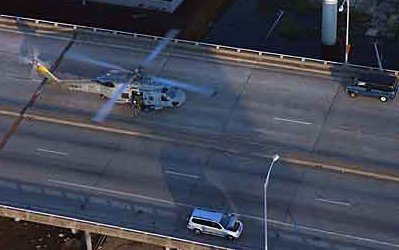 US Navy SH-60F Seahawk from HS-75 near the New Orleans Superdome
US Navy SH-60F Seahawk from HS-75 near the New Orleans Superdome
The demand for aircraft, particularly helicopters, led to the deployment of aircraft from across the services and the country. Helicopter Antisubmarine Squadron Light (HSL) 43, HSL-47, and HSL-49, and HSC-21 arrived from NAS North Island, Calif., with their MH-60 Seahawks. Three Marine squadrons from MCAS New River, N.C., sent six CH-53E Super Stallions and two CH-46E Sea Knights, and Heavy Helicopter Squadron (HMH) 772, a reserve squadron from Willow Grove, Pa., sent four more Super Stallions. Naval Aviation units also provided key logistical support; Fleet Logistics Support Squadron (VR) 57 and VR-58 moved in Seabees and HSL crewmen; evacuated hundreds of citizens; and transported tons of supplies.
 U.S. Army Ft. Polk Lousiana units were the first active duty Army units to conduct missions of New Orleans after Katrina hit.
U.S. Army Ft. Polk Lousiana units were the first active duty Army units to conduct missions of New Orleans after Katrina hit.
 US Army's 282nd Aviation Battalion, Fort Bragg, NC ( UH-60L Black Hawks )
US Army's 282nd Aviation Battalion, Fort Bragg, NC ( UH-60L Black Hawks )
 Fort Hood, TX
B Troop, 1-158th Aviation Regiment, 21st Cavalry Brigade was in the Gulf Coast Region for 6 weeks, which was longer than any other active duty unit, operating 8 UH-60A Black Hawks from 5 different locations. They also documented damaged areas and dropped sand bags to assist with flood control.
Fort Hood, TX
B Troop, 1-158th Aviation Regiment, 21st Cavalry Brigade was in the Gulf Coast Region for 6 weeks, which was longer than any other active duty unit, operating 8 UH-60A Black Hawks from 5 different locations. They also documented damaged areas and dropped sand bags to assist with flood control.
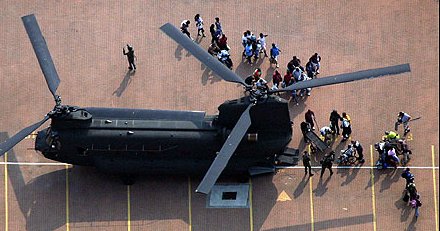 US Army CH-47 Chinook evacuating people from the New Orleans Convention Center
US Army CH-47 Chinook evacuating people from the New Orleans Convention Center
 U.S. Air Ambulance Detachment ( USAAAD) ( UH-1V Hueys )
U.S. Air Ambulance Detachment ( USAAAD) ( UH-1V Hueys )
 JRTC (Joint Readiness Training Center) Flight Detachment ( UH-60A Black Hawks )
JRTC (Joint Readiness Training Center) Flight Detachment ( UH-60A Black Hawks )
 US Army Reserve's B Co., 5th Battalion, 159th Aviation Regiment from Fort Eustis, Va. ( Their CH-47 Chinooks dropped more than a million pounds of the sandbags to help repair damaged levees around New Orleans. )
US Army Reserve's B Co., 5th Battalion, 159th Aviation Regiment from Fort Eustis, Va. ( Their CH-47 Chinooks dropped more than a million pounds of the sandbags to help repair damaged levees around New Orleans. )
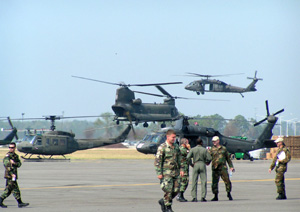 National Guard helos at the Mississippi National Guard Combat Readiness Training Center
National Guard helos at the Mississippi National Guard Combat Readiness Training Center
 National Guard's 1st Battalion 137 th Aviation Regiment from Akron-Canton, Ohio ( CH-47 Chinooks )
National Guard's 1st Battalion 137 th Aviation Regiment from Akron-Canton, Ohio ( CH-47 Chinooks )
 National Guard's 1st Battalion 131 th Aviation Regiment from Birmingham, Al ( UH-60A Black Hawks )
National Guard's 1st Battalion 131 th Aviation Regiment from Birmingham, Al ( UH-60A Black Hawks )
 National Guard's 148th Medical Co (Air Ambulance) from Winder, Ga ( UH-1V Hueys )
National Guard's 148th Medical Co (Air Ambulance) from Winder, Ga ( UH-1V Hueys )
 National Guard's 149th Air Ambulance from Martindale Army Air Field, Tx ( UH-60A Black Hawks )
National Guard's 149th Air Ambulance from Martindale Army Air Field, Tx ( UH-60A Black Hawks )
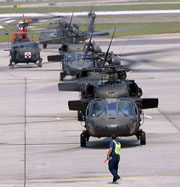
 US Air Force's 347th Expeditionary Rescue Group from Moody, Ga ( More than 20 HH-60G Pave Hawks
operating from Allen C. Thompson Air National Guard Base in Jackson, Miss )
US Air Force's 347th Expeditionary Rescue Group from Moody, Ga ( More than 20 HH-60G Pave Hawks
operating from Allen C. Thompson Air National Guard Base in Jackson, Miss )
 USAF 620th Air Expeditionary Squadron:
US Air Force Space Command deployed eight
Bell UH-1Ns with their 83 pilots, maintainers and support
personnel to Columbus Air Force Base, Miss.,
making up the 620th Air Expeditionary Squadron to aid in hurricane relief efforts beginning Sept. 2.
USAF 620th Air Expeditionary Squadron:
US Air Force Space Command deployed eight
Bell UH-1Ns with their 83 pilots, maintainers and support
personnel to Columbus Air Force Base, Miss.,
making up the 620th Air Expeditionary Squadron to aid in hurricane relief efforts beginning Sept. 2.
This is the first time the command has assigned helicopters outside its normal area of operations.
The helicopters assigned to 20th Air Force are primarily dedicated to providing security top cover for America’s ICBM force. However, because of their inherent capabilities, such as forward-looking infrared system, they are also ideally suited for search-and-rescue missions.
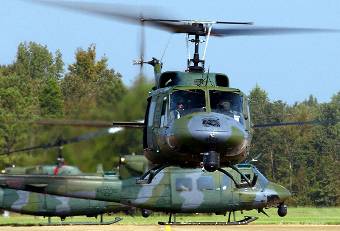
 Bell Helicopter Textron :
In coordination with FEMA, they dispatched six helicopters to the Gulf
area. They were one Bell 430, one Bell 206L4, and four Bell 407s including
one NVG (night vision goggles) equipped on station in Lafayette, LA. flying medical aid missions.
In all sixteen pilots and customer service representatives from Bell joined forces with federal and local agencies.
Bell Helicopter Textron :
In coordination with FEMA, they dispatched six helicopters to the Gulf
area. They were one Bell 430, one Bell 206L4, and four Bell 407s including
one NVG (night vision goggles) equipped on station in Lafayette, LA. flying medical aid missions.
In all sixteen pilots and customer service representatives from Bell joined forces with federal and local agencies.

 Canada:
On September 2 the Government of Canada announced it was sending three warships, along with
a Coast Guard vessel, with three CH-124 Sea King to the area.
Over 1,000 personnel are involved in the operation, including engineers and navy divers.
Canada:
On September 2 the Government of Canada announced it was sending three warships, along with
a Coast Guard vessel, with three CH-124 Sea King to the area.
Over 1,000 personnel are involved in the operation, including engineers and navy divers.

 Netherlands:
The Koninklijke Marine (Royal Netherlands Navy ) 's frigate Hr.Ms. Van Amstel arrived from the Netherlands Antilles
with her Westland Lynx attachment onboard.
Netherlands:
The Koninklijke Marine (Royal Netherlands Navy ) 's frigate Hr.Ms. Van Amstel arrived from the Netherlands Antilles
with her Westland Lynx attachment onboard.

 Republic of Singapore Air Force:
Three Singaporean CH-47 Chinooks and 38 RSAF personnel from a training
detachment based in Grand Prairie, Texas assisted in relief operations from 1 September.
They had so far ferried about 700 evacuees and hauled tons of supplies in 39 sorties on 4
September.
Republic of Singapore Air Force:
Three Singaporean CH-47 Chinooks and 38 RSAF personnel from a training
detachment based in Grand Prairie, Texas assisted in relief operations from 1 September.
They had so far ferried about 700 evacuees and hauled tons of supplies in 39 sorties on 4
September.
See also:It formed over the Bahamas on August 23, 2005, and crossed southern Florida as a moderate Category 1 hurricane, but causing some deaths and flooding there, before strengthening rapidly in the Gulf of Mexico and becoming one of the strongest hurricanes on record. The storm weakened considerably before making its second and third landfalls as a Category 3 storm on the morning of August 29 in southeast Louisiana and at the Louisiana/Mississippi state line, respectively.
Military response to the massive natural disaster included all services aviation assets from across the country.
The United States Northern Command established Joint Task Force (JTF) Katrina based out of Camp Shelby, Mississippi, to act as the military's on-scene command on Sunday, August 28. Approximately 58,000 National Guard personnel were activated to deal with the storm's aftermath, with troops coming from all 50 states.
Military helicopters continued airlifts throughout the days, ferrying in supplies and taking many people out of New Orleans to the Louis Armstrong International Airport in nearby Kenner. By September 3, according official reports the facility so far has processed 40,000 people, with priority given to the sick and injured.
The United States Northern Command established Joint Task Force (JTF) Katrina based out of Camp Shelby, Mississippi, to act as the military's on-scene command on Sunday, August 28. Approximately 58,000 National Guard personnel were activated to deal with the storm's aftermath, with troops coming from all 50 states.
Military helicopters continued airlifts throughout the days, ferrying in supplies and taking many people out of New Orleans to the Louis Armstrong International Airport in nearby Kenner. By September 3, according official reports the facility so far has processed 40,000 people, with priority given to the sick and injured.
 FEMA search and rescue team prepare to board a National Guard Chinook
FEMA search and rescue team prepare to board a National Guard Chinook
Coast Guard helicopters where already on scene and several days into the disaster, National Guard helicopter crews joined the desperate effort, using less well-equipped UH-1 Hueys hugging one or two survivors up time after time. And by the end of the week, the skies over New Orleans were a beehive of rotary wing activity, with craft as large as the huge Skycrane or tandem rotor Chinooks , large Sikorsky H-53s along with most every other helicopter model in the Armed Forces inventory.
The Army's III Corps and two Air Force rescue wings contributed over 30 helos as well. At the height of operations, the various elements of the Department of Defense had more than 350 helicopters and over 70 fixed wing aircraft involved in Katrina relief efforts. Below is a summary of the helicopter units deployed:
US Coast Guard


On the afternoon of the storm, NAS JRB New Orleans' emergency management team quickly moved into action to clear the runways and repair the control tower. Within four hours, flight operations began when the first Coast Guard HH-65 landed at the JRB to start relief operations. The Coast Guard had also prepositioned rescue helos to Shreveport, La., and other aviation assets in staging areas near the threatened area in advance of the storm. By 5 September, the Coast Guard had 43 helicopters and 8 fixed wing aircraft conducting operations in the region.
Of the 60,000 people stranded in New Orleans, the US Coast Guard rescued over 33,500. Congress recognized the Coast Guard's response with an official entry in the Congressional Record and the Armed Service was awarded the Presidential Unit Citation.
Hour by hour, pilots held their MH-65 Dolphins or MH-60 Jayhawks helicopters in rock-steady hovers as their crewmen lowered rescue baskets and raised up desperate survivors one by one. Hour by hour they worked, pausing only to refuel, their crews at times needing to be all but ordered to sleep and comply with the crew duty limitations.
The Coast Guard raced tirelessly to save as many as possible, maintaining its superlative safety procedures to make sure the crews and rescuees made it back every time.
US Naval Aviation and US Marine Corps
NAS Pensacola, Fla., was the base for over 30 Navy and Marine aircraft involved in the operation.
Assault carrier USS Bataan (LHD 5) was
already operating in the region as the storm approached. She steamed westward to embark
four MH-53s from HM-15 based at NAS Corpus Christi, Texas,
which joined two MH-60s
from Helicopter Sea Combat Squadron (HSC) 28 already on board. Late in the afternoon
of 30 August these helos began search and rescue operations in the vicinity of New Orleans.
The Navy soon sent assets from the Norfolk, Va., area, including three amphibious ships: USS Iwo Jima (LHD 7), USS Shreveport (LPD 12), and USS Tortuga (LSD 46). On 4 September, Iwo Jima moored pierside in downtown New Orleans and became a hub for military and civilian helicopter activity in the heart of the city. The amphib became the HQ for Joint Task Force Katrina led by Army Lt. Gen Russell Honore. Aircraft carrier USS Harry S. Truman (CVN 75) also deployed to the area along with USS Whidbey Island (LSD 41) on September 1st. Truman embarked elements of 13 Navy helicopter squadrons and by deploying close to the disaster area, shortened the mission time for operations that had previously been flown from Pensacola. The carrier also provided support to NAS JRB New Orleans in the form of aviation boatswain's mates and cooks to keep that vital station in operation.
The Navy soon sent assets from the Norfolk, Va., area, including three amphibious ships: USS Iwo Jima (LHD 7), USS Shreveport (LPD 12), and USS Tortuga (LSD 46). On 4 September, Iwo Jima moored pierside in downtown New Orleans and became a hub for military and civilian helicopter activity in the heart of the city. The amphib became the HQ for Joint Task Force Katrina led by Army Lt. Gen Russell Honore. Aircraft carrier USS Harry S. Truman (CVN 75) also deployed to the area along with USS Whidbey Island (LSD 41) on September 1st. Truman embarked elements of 13 Navy helicopter squadrons and by deploying close to the disaster area, shortened the mission time for operations that had previously been flown from Pensacola. The carrier also provided support to NAS JRB New Orleans in the form of aviation boatswain's mates and cooks to keep that vital station in operation.
 US Navy SH-60F Seahawk from HS-75 near the New Orleans Superdome
US Navy SH-60F Seahawk from HS-75 near the New Orleans Superdome
The demand for aircraft, particularly helicopters, led to the deployment of aircraft from across the services and the country. Helicopter Antisubmarine Squadron Light (HSL) 43, HSL-47, and HSL-49, and HSC-21 arrived from NAS North Island, Calif., with their MH-60 Seahawks. Three Marine squadrons from MCAS New River, N.C., sent six CH-53E Super Stallions and two CH-46E Sea Knights, and Heavy Helicopter Squadron (HMH) 772, a reserve squadron from Willow Grove, Pa., sent four more Super Stallions. Naval Aviation units also provided key logistical support; Fleet Logistics Support Squadron (VR) 57 and VR-58 moved in Seabees and HSL crewmen; evacuated hundreds of citizens; and transported tons of supplies.
US Army, US Army Reserve and Army National Guard
 US Army CH-47 Chinook evacuating people from the New Orleans Convention Center
US Army CH-47 Chinook evacuating people from the New Orleans Convention Center
 National Guard helos at the Mississippi National Guard Combat Readiness Training Center
National Guard helos at the Mississippi National Guard Combat Readiness Training Center

US Air Force
This is the first time the command has assigned helicopters outside its normal area of operations.
The helicopters assigned to 20th Air Force are primarily dedicated to providing security top cover for America’s ICBM force. However, because of their inherent capabilities, such as forward-looking infrared system, they are also ideally suited for search-and-rescue missions.

